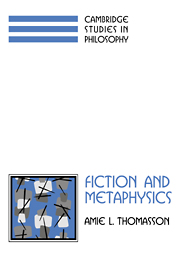Book contents
- Frontmatter
- Contents
- Acknowledgments
- Introduction: From Fiction Into Metaphysics
- Part One The Artifactual Theory of Fiction
- Foreword
- 1 If we postulated fictional objects, what would they be?
- 2 The nature and varieties of existential dependence
- 3 Fictional characters as abstract artifacts
- 4 Reference to fictional characters
- 5 Identity conditions for fictional characters
- Part Two Ontological decisions
- Notes
- Bibliography
- Index
3 - Fictional characters as abstract artifacts
Published online by Cambridge University Press: 23 September 2009
- Frontmatter
- Contents
- Acknowledgments
- Introduction: From Fiction Into Metaphysics
- Part One The Artifactual Theory of Fiction
- Foreword
- 1 If we postulated fictional objects, what would they be?
- 2 The nature and varieties of existential dependence
- 3 Fictional characters as abstract artifacts
- 4 Reference to fictional characters
- 5 Identity conditions for fictional characters
- Part Two Ontological decisions
- Notes
- Bibliography
- Index
Summary
In the intuitive view initially presented, fictional characters are higher-level dependent entities, indeed entities dependent in a variety of ways on a variety of entities. We can now outline precisely what those dependencies are and see that, as a result of those dependencies, fictional characters turn out to be abstract artifacts, a kind of entity often encountered yet little acknowledged. To make their ontological status clearer, I begin by using the prior work on dependence to make the intuitive version of the artifactual theory more precise and then turn to investigate how such dependent entities fit into a general modal metaphysics.
DEPENDENCIES OF FICTIONAL CHARACTERS
The immediate dependencies of a fictional character are first, on the creative acts of its author or authors, and second, on a literary work. Clearly the dependence of a fictional character on the intentional acts of its creator or creators is a rigid historical dependence. Its historical dependence on certain forms of intentionality signals it as an artifact, an object created by the purposeful activity of humans (or other intelligent beings). We are certainly no strangers to artifacts; on the contrary artifacts from computers to cutlery to couches are those entities that surround us most immediately in our everyday life. Yet little has been done to incorporate them into a philosophical ontology, perhaps in part because of fears that conditions for their identity would be too thorny, and in part because too little has been said about dependence on the thoughts and practices of human beings.
- Type
- Chapter
- Information
- Fiction and Metaphysics , pp. 35 - 42Publisher: Cambridge University PressPrint publication year: 1998



